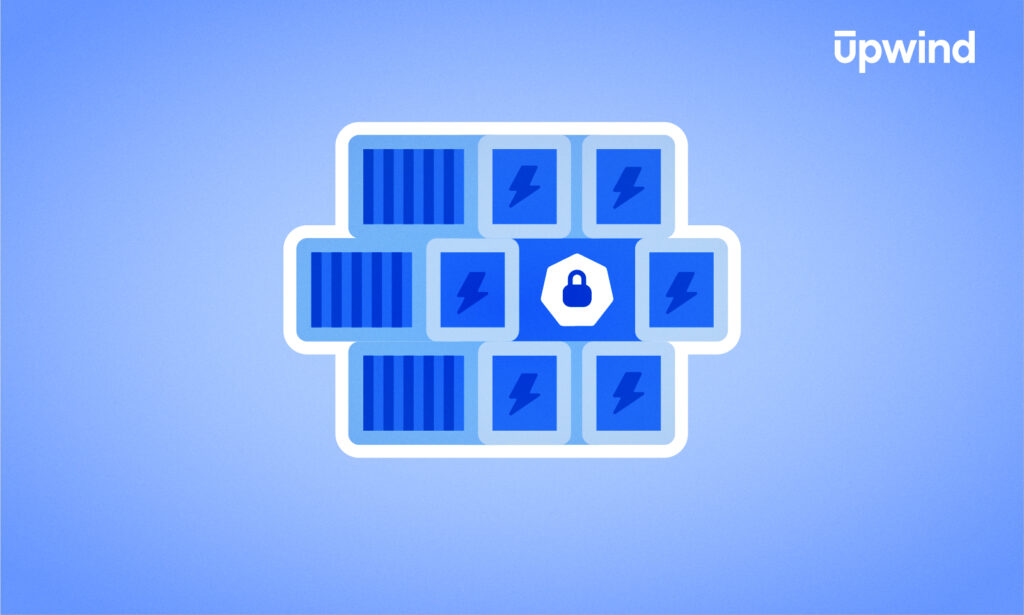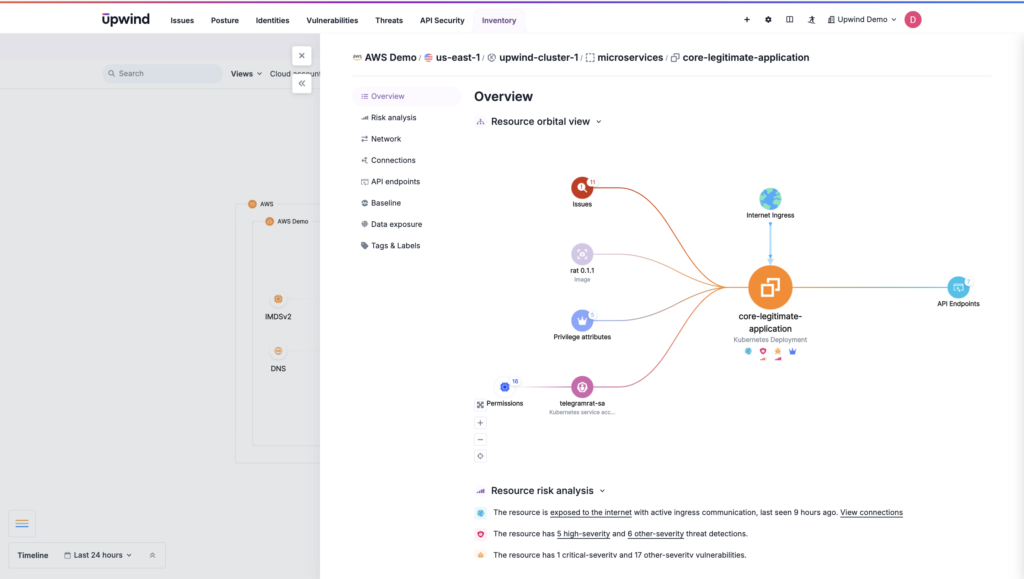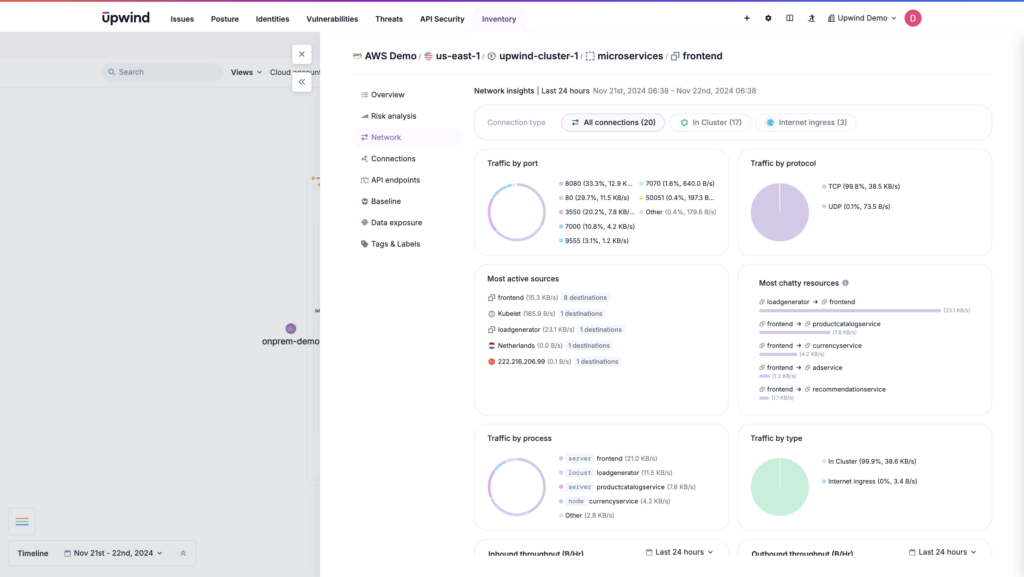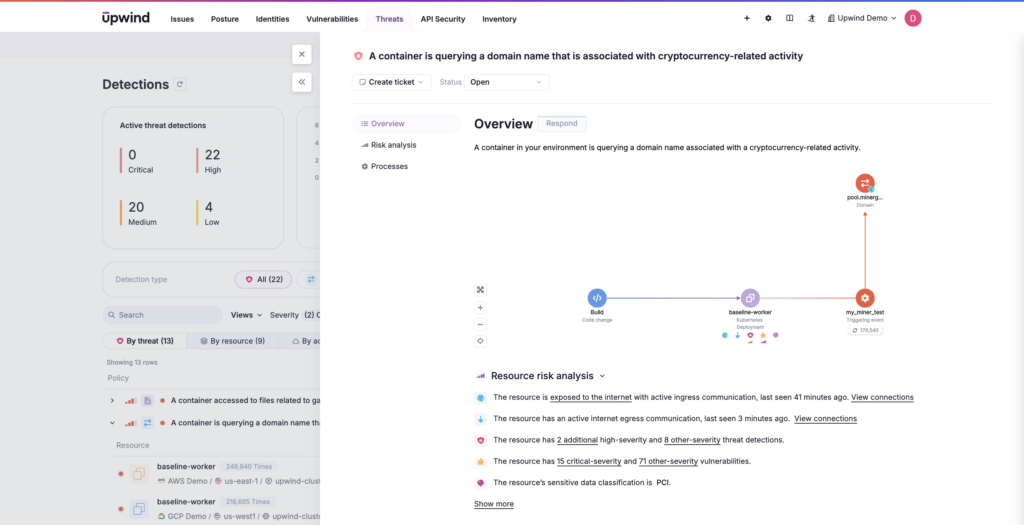
Kubernetes runtime security is a crucial component of defending cloud environments. Whereas build-time protection secures containers and Kubernetes (often abbreviated K8s) architecture during the development phase, runtime security protects systems during the operation phase when containers are susceptible to some of the most damaging attacks. Do K8s really need specific security? Would it differ from simple container security? And why runtime security? We’re going deeper.
Understanding Kubernetes Runtime Security
Kubernetes runtime security encompasses the practices, methods, and technologies that protect containerized workloads and the cluster itself during the operation phase. It focuses on detecting, mitigating, and preventing threats in real time, ensuring the safety of running applications, network communications, and sensitive data, and may include core practices such as:
- Workload and pod security
- Runtime threat detection and observability
- Network security and zero-trust principles
- Secrets and sensitive data management
- Access control and policy enforcement
- Container image and file integrity
- Audit logging and incident response
- Application behavior baselines
- Ephemeral workloads and vulnerability management
These runtime security practices for Kubernetes don’t differ significantly from runtime security practices for other containerized workloads.
They all secure workloads during runtime, which is essential sicne pre-runtime security measures can’t predict all real-world scenarios, are challenging in dynamic, ephemeral environments, can’t address active threats, and can’t isolate threats to protect other workloads in cluster components.
However, Kubernetes introduces additional complexity due to its unique nature — Kubernetes is a dynamic, multi-tenant environment with abstractions like pods, services, and namespaces. Unlike standalone container runtimes, Kubernetes requires tighter integration of runtime security practices across these layers to ensure comprehensive protection. Further, the orchestration layer also introduces unique attack surfaces, such as the API server and control plane, which must be secured alongside workloads, while the ephemeral nature of Kubernetes workloads makes traditional runtime monitoring and forensics more challenging.
Kubernetes runtime security has evolved to contend with the threats that arise at certain levels of the Kubernetes environment, from individual containers to the broader cluster and network infrastructure.
Runtime and Kubernetes Container Scanning with Upwind
Upwind delivers runtime-powered Kubernetes container scanning, providing real-time threat detection, contextualized analysis, and rapid remediation. With root cause analysis that’s 10X faster than traditional methods, Upwind is tailored for the dynamic needs of Kubernetes environments.
Common Threats to Kubernetes Runtime Security
Traditional security measures are ill-suited for the dynamic nature of Kubernetes environments. Containers are ephemeral by nature, with images being copied and deployed within minutes. By the time traditional security tools like endpoint detection and response or threat detection engines can flag an issue in a container, the threat has already moved deeper into the organization’s infrastructure. That can be tough as more and more organizations turn to this convenient, scalable orchestration platform.
According to the Cloud Native Computing Foundation, 53% of organizations are using Kubernetes in production.
Kubernetes’ ephemeral nature makes it incredibly flexible, but it also complicates the strategies required to protect this ever-changing environment. Let’s examine the risks by their targets: containers, hosts, clusters, and networks.
Container-Level Runtime Security Issues
Container-level security issues include potential vulnerabilities at the scale of the individual container. These include potential problems such as:
- Image vulnerabilities – These are flaws in the container image before deployment. Running vulnerability scans on container images can flush these out, but that’s only if the vulnerability is known.
- Privilege escalation – Threat actors may try to escalate their access from an individual container either by exploiting a vulnerability or taking advantage of privileges granted to a container in error.
- Escape attempts – Containers are typically isolated from the host system, but attackers can exploit container-level runtime vulnerabilities to attempt an escape into the host system.
- Malicious code injection – If they gain access to a container, attackers may be able to add malicious code that spreads to other parts of the cluster.

Host-Level Runtime Security Vulnerabilities
Host-level runtime security vulnerabilities target the underlying physical or virtual machines that support containerized workloads, posing risks that can destabilize infrastructure or enable further risks.
- Compromised hosts – If the physical or virtual machine that hosts containers is compromised, it can provide attackers with the foothold they need to attack the basic infrastructure of Kubernetes and containers.
- Excessive resource usage – Whether intentional or not, excessive use of resources by a container could result in denial of service. Examples of excessive resource usage include containers using too many CPU cycles or sending and receiving too much traffic. Overconsumption of resources could trigger system instability and be a sign of a denial of service attack, data exfiltration, or crypto mining.

Cluster-Level Threats
This class of threats targets Kubernetes clusters as a whole, including all nodes and applications. If successful, these attacks could disable clusters and cause running apps to become unavailable. Examples of common cluster-level vulnerabilities include:
- Unauthorized access: Threat actors with unauthorized access to the Kubernetes API can abuse cluster resources.
- API abuse: Malicious or legitimate users can misuse the Kubernetes API to cause disruptions.
- Secrets theft: Sensitive information stored in Kubernetes Secrets may become exposed.
- Lateral movement: Attackers may be able to move between containers within a cluster and spread the infection further.

Effectively addressing Kubernetes runtime security requires a layered approach that accounts for threats across containers, hosts, clusters, and networks. With Kubernetes’ inherent complexity and ephemeral workloads, runtime security is a requirement. That means supporting workloads with capabilities like real-time visibility, anomaly detection, and tools that can enforce security policies and mitigate risk in these dynamic environments.
Navigating Kubernetes Runtime Trade-Offs
Leveraging Kubernetes runtime security isn’t just a matter of implementing best practices. It’s about how to optimize them. Runtime security offers powerful benefits like real-time threat detection and workload isolation, but it often comes with challenges like false positives, resource constraints, and scalability concerns.
Let’s explore individual aspects of runtime security, balancing strengths and considerations to maximize Kubernetes runtime security with fewer trade-offs.
| Strengths | Considerations | Upwind’s Approach | |
| Threat Detection | Immediate detection of anomalies like privilege escalation or lateral movement. Reduced false positives through behavioral analysis | Continuous monitoring may require resource allocationRegular updates to detection algorithms help adapt to evolving threats | Uses eBPF-powered sensors for real-time analysis of API requests and workload behavior. Offers adaptive anomaly detection for evolving workloads |
| Workload Isolation | Limits blast radius of attacks. Enhances compliance by ensuring clear boundaries of control between workloads | Policy misconfigurations can lead to service disruptionsRegular audits are required to verify alignment of runtime policies with the intended security posture. Resource overhead from running less easily scaled isolated environments | Monitors container and pod-level configurations at runtime to instantly detect misconfigurations or deviations from expected security policies. Alerts users in real-time to reduce risk without interrupting DevOps workflows |
| Resource Monitoring | Flags excessive CPU, memory, or traffic usage indicative of potential DoS and crypto-jacking attempts. Enables proactive resource management | Requires tuning to avoid unnecessary alerts. Continuous evaluation helps adapt to workload changes | Provides real-time visibility into resource usage with contextual baselines |
| Secrets Management | Captures detailed data of runtime incidents for analysis and compliance | Misconfigurations can lead to data leaks. Regular reviews of access controls are necessary | Monitors access to secrets and sensitive data and detects unauthorized usage |
| Cluster API Monitoring | Tracks API activity. Secures Kubernetes control plane | Performance overhead in large clusters | Tracks API activity in real time to detect unauthorized access or abuse |
| Network Security | Simplifies the creation and enforcement of network policies. Detects unusual network behaviors | Complex configurations may block legitimate traffic. Requires updates to adapt to network changes | Provides real-time visibility into network topology and resource communication. |
| Audit Logging and Forensics | Captures runtime incident data for investigation. Supports compliance reporting | Log storage and processing can strain resources. May requires integration with analysis tools | Captures a detailed data of runtime incidents for analysis and compliance |
| Scalability | Maintains consistent security coverage across large environments. Supports multi-cloud and hybrid deployments | Ensuring consistent policy enforcement across clusters can be challenging. Regular testing helps validate scalability | Designed to adapt to dynamic, ephemeral Kubernetes workloads, including in multi- and hybrid-cloud environments |
Tackling Kubernetes runtime security needs individually allows for fine-tuned solutions tailored to specific aspects like API monitoring, workload isolation, or secrets management for simple, streamlined solutions.
However, this fragmented approach can lead to increased complexity with inefficiencies in correlating data across tools. Unified platforms, like a Cloud Native Application Protection Platform (CNAPP) enhance visibility across containers, hosts, clusters, and networks without the need for integrations and are particularly well-positioned to handle Kubernetes environments where real-time protection is important.
Is Runtime Security Best for Kubernetes?
Runtime security is particularly crucial for complex and ephemeral applications like those in Kubernetes environments. But relying solely on runtime security is not enough. The strongest security posture for Kubernetes combines runtime with build-time security so that insights gained at runtime can be used to fortify development work, feeding a virtuous cycle of continuous improvement.
How do build-time and runtime security complement one another? Here are three simple ways:
- Build-time security prevents issues before deployment. Scanning container images for vulnerabilities or outdated libraries ensures only secure and compliant workloads are deployed to Kubernetes clusters.
- Build-time security reduces the runtime attack surface. Addressing issues early in the software development lifecycle reduces the likelihood of privilege escalation from overly permissive pod configurations, lateral movement from unscanned container images, and exposure of misconfigured Kubernetes Secrets.
- Build-time security provides runtime insights. Data reigns supreme in identifying runtime issues when they crop up as unexpected changes. Metadata from image scans, for example, can help runtime tools identify malicious processes or provide a reference point for detecting anomalies.
However, build-time insights alone are not enough – runtime is still necessary.
First, runtime is the only way to identify threats that emerge only post-deployment, like zero-day vulnerabilities, insider threats, or advanced persistent threats (APTs) that can bypass build-time controls.
Kubernetes’ dynamic, ephemeral environment also means real-time monitoring is necessary to handle shifting workloads and scale securely. That adds to their complicated attack surface, too. The Kubernetes API server, control plane, and pod network create unique attack vectors that runtime tools are best equipped to manage.
Shift-Right for Better Kubernetes Runtime Security with Upwind
The Upwind Cloud Native Application Protection Platform (CNAPP) is designed to support Kubernetes runtime security with a shift-right approach and features designed for ephemeral and cluster environments. While many cloud protection solutions emphasize build-time protections with containers and Kubernetes, this approach focuses on securing container images at runtime through intelligent eBPF monitoring.
Add behavioral analysis, prioritized alerts, and visibility across ephemeral environments — and cloud platforms — while proactively protecting against common Kubernetes attacks. Upwind integrates with existing security tools and workflows, such as SIEMs and EDRs, to create a unified approach to protecting your Kubernetes cloud environments.
To learn more about Upwind’s approach to Kubernetes runtime security and get advice on best practices, schedule a demo.
Kubernetes Runtime Security FAQ
What’s the difference between build-time and runtime security in Kubernetes?
In Kubernetes, build-time security focuses on securing containerized workloads during the development and deployment stages. That includes container image scanning, configuration validation, policy enforcement, and infrastructure as code (IaC) security.
Runtime security focuses on containerized workloads during the operation phase, monitoring for threats, enforcing network security, protecting secrets, and handling incident response, isolation, and containment to prevent the spread of an attack and log issues for forensic analysis and compliance.
For runtime security, active attacks and real-time threats are core goals.
How can organizations implement Kubernetes runtime security without impacting performance?
Optimizing tools and workflows helps balance efficiency with security. Some key changes that can help tremendously are:
- Using lightweight monitoring tools, like an eBPF-based sensor
- Automating security analysis with tools like behavioral baselines
- Focusing on policy enforcement at the pod-level
- Adopting a zero-trust model
- Optimizing resource allocation by monitoring for resource usage
- Prioritizing key workloads when necessary, focusing on critical workloads first
- Testing and optimizing regularly for awareness of how security tools behave in real-world scenarios
What are the key metrics for measuring runtime security effectiveness?
Key metrics for measuring runtime security effectiveness include:
- Mean time to detect (MTTD)
- Mean time to respond (MTTR)
- Number of vulnerabilities resolved
- Number of clusters being monitored
These are not the only metrics to track the effectiveness of runtime security — operational metrics like threat containment rate and log completeness are also popular.
In general, security teams align the metrics they prefer to their broader security goals. For instance, if it’s most important to increase compliance, the number of vulnerabilities resolved can take precedence. But sometimes, those vulnerabilities aren’t critical, so their resolution doesn’t change the organization’s overall security position. Adopting a balanced approach allows security teams to evaluate runtime security holistically.
Combining compliance metrics with policy adherence and operational metrics such as incident recurrence rates, for example, can provide the clearest picture of both the immediate and long-term effectiveness of security measures.





